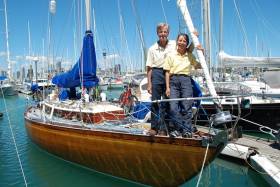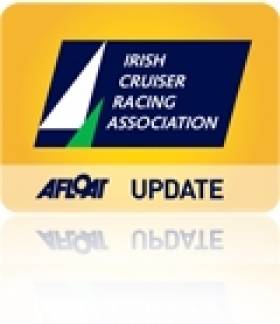Displaying items by tag: Irish Sea Offshore Racing Association
In view of the light wind forecast this weekend ISORA are making provisions for a finish outside Dublin Bay for its fourth race of the series from Holyhead to Dun Laoghaire tomorrow. ISORA will also be using virtual waypoints for the 50–mile race.
The forecast appears to be no deterrent as a bumper fleet of 29 has confirmed for the Irish Sea duel. The ISORA fleet nearly broke the 30–boat ceiling except for two unavoidable last minute pull–outs this morning.
The reason behind a Kish light as opposed to a Pier finish is that it is envisaged that there will be no wind in the bay when the fleet arrives late tomorrow afternoon.
The tracker managed finish line – between North Kish and Kish light will give accurate crossing times to within approx five seconds. Is this is the first time an offshore race has been 100% finished using technology alone?
We take it for granted, and it’s always there - whether we like it or not. The good old Irish Sea. But could it be that there’s a new and growing awareness of just how much the Irish Sea can offer if you’re interested in cruiser-racing which really does test a boat and crew’s ability to do what the boat was designed to do? In other words, going offshore, and staying offshore for a decent distance of the course, rather than using the boat only for semi-inshore races which could perfectly well be done by craft with no accommodation at all. W M Nixon wonders if the long-forecast re-birth of the Irish Sea Offshore Racing Association really has been happening while we all were looking elsewhere.
It was some time ago now, several years it must be, when a function was scheduled for the National Yacht Club in the dark days of November. At it, former enthusiasts from both sides of the Irish Sea were going to get together to have a proper-job black tie gala dinner to finally lay to rest the ghost of the Irish Sea Offshore Racing Association, which had been attracting little or no turnouts for events which used to be the backbone of a busy annual offshore racing programme which had been the envy of many comparable sailing areas.
Part of the idea was that by giving it a decent burial, the numerous trophies could be re-distributed to clubs which might find a better use for them, and who knows, but maybe in individual cases specific and historic distance events might be kept going on a stand-alone basis.
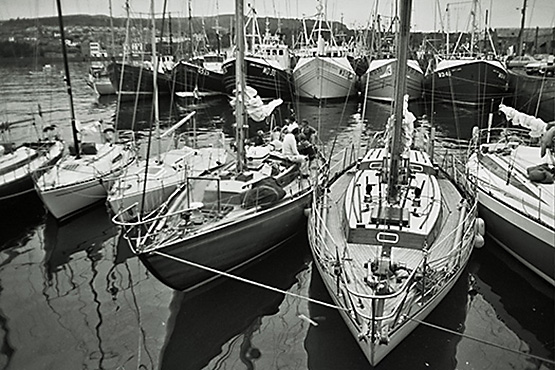
Sunstone (centre) with ISORA racers among the fishing boats in the pre-marina days in Howth during the 1970s. Photo: W M Nixon
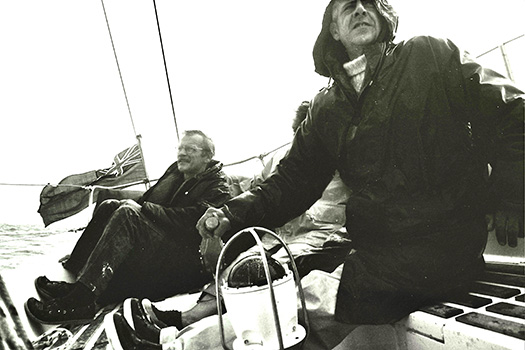
If ISORA could be said to have a single founder back in 1971, it was Dickie Richardson of Holyhead (left), seen here aboard his Ohlson 38 Matthew Walker which he completed with his sons from a bare hull. Photo: W M Nixon
At least that’s my recollection, but it’s vague in the extreme, for although like many the annual ISORA programme used to dominate my summers, those days were long gone, surrendered – sometimes rather unwillingly, it has to be admitted – to growing family demands.
Time was when the husband of the household was expected to be away at sporting things most weekends. But that attitude was changing very rapidly, and you only had to look at ISORA turnouts to see the change in domestic priorities taking place as a fact of life in its new form.
Of course there were some splendid family crews racing offshore involving two and sometimes three generations. But as other forms of sport and specialist interests developed, such crews became increasingly rare, and anyway offshore racing wasn’t everyone’s cup of tea. So you could argue that the thing that almost killed off ISORA was the most scary advertising slogan of our times, five seemingly innocuous little words which promote any event or activity which reflects the new domestic priorities.
“FUN FOR ALL THE FAMILY!!!!!!” For dyed-in-the-wool offshore racers of the rather anti-social traditional type, hearing or seeing this chirpy message was like showing the sign of the cross to a vampire on the prowl. And for enthusiasts of the smelly crazy sport of taking a three day weekend to position and return an offshore racer for a distance race involving kindred spirits from God knows where, it meant death by a million painful pinpricks.
So much so, in fact, that we who were formerly addicted were brainwashed into totally abandoning our old ways. Thus when I heard that a dinner was maybe being planned to wind up dear old ISORA, excuses were readily forthcoming for being elsewhere.
Except that reports of the death of ISORA proved to be greatly exaggerated. Memories are vague in the extreme. And anyway I wasn’t there, even though I’d been in and around the birth of ISORA way back in the early 1970s. But in this instance I don’t want to spoil the myth by asking specific questions of those who were there a few years back about that supposed Laying To Rest That Never Happened. For my impression is that, owing to a November mega-gale, the ferry from Holyhead was unable to sail. The Welsh and English contingents didn’t get to the requiem dinner in the first (or last) place. And the Irish crowd enjoyed themselves so much they decided they were going to keep ISORA going after all.

The National Yacht Cub, where ISORA was re-born

Failure is an orphan, but success has parents everywhere. Nevertheless I think few will disagree with the assertion that it is former NYC Commodore Peter Ryan, with the help of Stephen Tudor from Pwllheli, who has done most to keep ISORA going on life support, and then start to revive it actively with sponsorship from Avery Crest when the time is right.
And that right time seems to be right now. ISORA is putting Lazarus in the ha’penny place with a very healthy turnout for today’s 54-mile Dun Laoghaire to Holyhead Race. With 28 boats coming to the line, and it still only mid-May, we’re looking at substantial growth which shows every sign of being sustainable, so maybe we should try to explain the odd appeal of short to middle distance offshore racing.
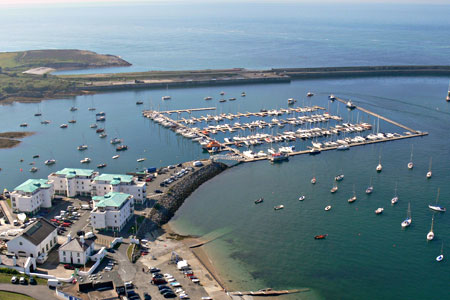
Holyhead is the destination for today’s ISORA cross-channel race. The marina in the corner of the harbour known as Porth y Fellyn is a world away from the popular perception of Holyhead as a raw ferry port.
Part of the answer has to be that once you’ve fulfilled all the complex tasks of bringing your boat up to the required standard in terms of equipment and crew qualifications, the actual event itself could not be simpler. The basic simplicity of an offshore race is its USP in today’s ludicrously complicated world. Unlike complex inshore multi-race regattas, there’s just one start, just one course, and just one finish line. Heaven knows but our everyday lives are weird enough and busy enough these days, thus it’s refreshing to find a sport whose basis is so utterly simple.
Of course there are all sorts of complexities of winds and tides and tactics and strategies underlying this basic simplicity. For instance, to an outsider, surey nothing could seem simpler than a race from Dun Laoghaire to Holyhead? Believe me folks, it may be a straight line across channel. But once you’re into it, you find the factors involved are infinite in their variety.
Yet underneath it all is this appealing simplicity of just the one start and just the one finish. And it goes on for long enough to build up a silent but strong relationship with the boats and crews you’re racing against. That old sailor’s opinion: “I don’t like the cut of his jib” can begin to have real meaning.
At ISORA’s height when the annual season-long points championship could involve more than a hundred boats when every event was included, the fleet was as diverse as it was long-lived. Today you see boats of the S & S 34 class, or a whole raft of Swans, or boats like Sarnia or Setanta, as being interesting yet still very much alive relics of a different age of sailing. And in this historic list, one boat in particular stands out. When we raced against her, she was called Dai Mouse III and she was owned by a Cheshire publican called David Hague. But nowadays - and for more than 25 years – she is known as Sunstone, the 40ft S&S sloop which Tomy and Vicky Jackson cruise the length and breadth of the globe with such competence that they recently became the latest awardees of the annual Blue Water Medal of the Cruising Club of America, which is tops of the tops.
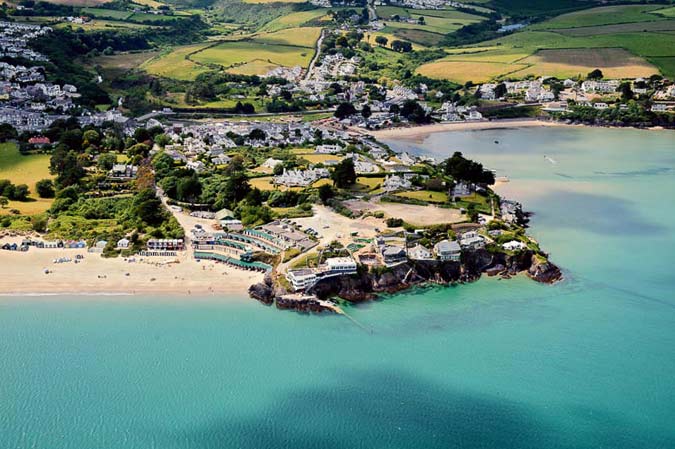
Abersoch on the Lleyn Peninsula in North Wales is another ISORA location. The clifftop clubhouse of South Carnarvon YC is reputedly suspended from its roof in a masterpiece of engineering.
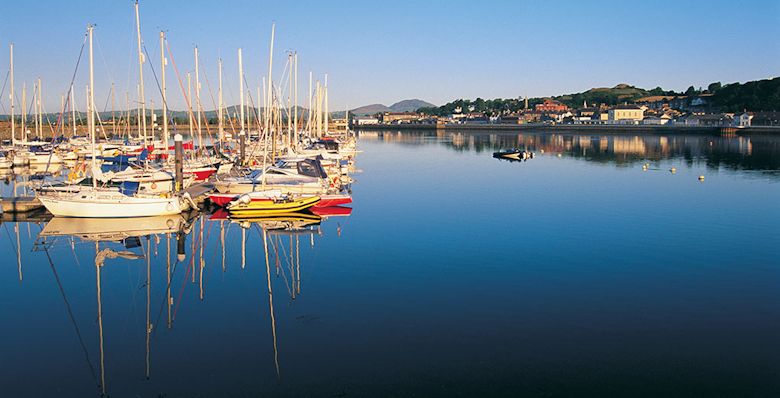
Pwllheli provides total shelter at the head of Tremadoc Bay when the ISORA fleet is in port
But for old ISORA hands, the attitude is that Dai Mouse III is doing well for herself, and it’s just right and proper. They could be an odd bunch, the ISORA people. The kind of people who take to offshore racing aren’t people who indulge in passing fads, and throwaway entertainments. They’re literally in it for the long haul. Yet they’re not the kind of people who’ll necessarily attach themselves to the high profile glitzy glamorous offshore events. Rather they go for the straightforward low-key distance races with a strong local tinge, races which provide them with private satisfaction, and an absorbing way of relaxing at weekends.
So obviously it’s not for everyone. In fact, it’s obviously not for the vast majority of the sailing population. Yet it’s not elitist. It’s a form of sailing which appeals to those who may not be the ultimate hotshots in club racing, but give them a moderate offshore challenge, and they come into their own. As for it being accessible, if you show genuine interest you’ll find you get involved, but it’s not for the casual thrill seeker who will be interested in something else entirely the following weekend. And exclusive? Of course it’s exclusive. If you can’t face with continued enthusiasm the thought of being cold and wet and in the dark and probably seasick now and again, then you’re automatically excluded.
Royal Dee Yacht Club Bicentenary Dinner Celebrations
The Royal Dee Yacht Club Bicentenary Dinner, the high point in their 200 year celebrations, took place at Eaton Park, Eccleston, Chester, on the 17th September 2015.
Eaton Park is the private residence of the Duke and Duchess of Westminster with whose kind permission this historic occasion took place in that special venue. The pre-dinner reception was held in the Long Room followed by dinner in the adjoining Wolf Room. During the reception, chamber music was provided by a period chamber orchestra.
Members and guests had a rare opportunity to view part of this spectacular estate that included the famous collection of carriages and the “Shell Grotto”. To mark the event, all the Royal Dee Yacht Club’s magnificent trophies, many of whom had been out on loan to yacht racing associations and had been recalled, were on display. Special commemorative silver lapel pins to mark the occasion were presented to all Royal Dee Yacht Club members present and a specially engraved souvenir of the event was presented to all members and their guests.
Dignitaries attending the event included the Commodores of the Royal Ocean Racing Club, the Royal Alfred Yacht Club, the Royal Anglesey Yacht Club and the Royal Mersey Yacht Club. The Irish Sea Offshore Racing Association, (ISORA) was represented by their Chairman, Peter Ryan, who is also a member of the Royal Dee Yacht Club.
The members and guests were treated to a sumptuous meal prepared by the Chester based Michelin star Chef, Simon Radley. A copy of the menu for the dinner is attached.
The Commodore of the Royal Dee Yacht Club, Derek Matthews, welcomed the members and guests while Vice Commodore, Callum Edge gave the Loyal Toast and the Toast to the Guests. The Reply to the Toast to the Guests was made by Commodore of the Royal Alfred Yacht Club, Barry MacNeaney. He emphasised the support that the Royal Dee Yacht Club has given over the years to offshore yacht racing. He also acknoweldged the historic strong and developing bonds between the Royal Dee Yacht club and yacht clubs on both sides of the Irish Sea.
The evening was a fitting tribute to this historic event and enjoyed by all who were privileged to have attended.
#isora – Racing under the burgee of the National Yacht Club, the third race in the Irish Sea Offshore Racing Association (ISORA) 2015 series will start from Scotsman's Bay on the south side of Dublin Bay early on Saturday morning. The Irish offshore fleet is fitted with yellowbrick trackers for the 60–mile race across the Irish Sea from Dun Laoghaire to Holyhead, an important warm up for next month's Dun Laoghaire to Dingle race, also from the NYC.
The reigning ISORA champion Ruth skippered by Liam Shanahan was the winner of April's first race coastal race of the season, a fortnight ago. The NYC J–109 took a six minute win on corrected time from the Irish National Sailing Club Reflex 38 Lynx skippered by Kenneth Rumball. Third in that race was the Arklow Sailing Club J122, Aquelina.
ISORA Race three sailing instructions are downloadable below.
Dickie Richardson 1926 – 2015
#isora – Dickie Richardson of Holyhead, who died last month aged 89, played a key role in the Irish Sea Offshore Racing Association during the Golden Age of distance racing in the area during the 1970s. Yet although he was best known as one of the moving spirits in the formation of ISORA in 1971, there was much more to him than this.
He was a remarkable man with an extraordinary ability to turn his hand to anything. Professionally, he was a consultant anaesthetist with some of his most noted work being done in the cardiothoracic surgical unit at Broad Green Hospital in Liverpool when open heart surgery was being developed, an area in which he was much involved.
But as was made clear at his well-attended funeral in Bangor, North Wales, he was an engineer at heart, a man who loved making and doing. He derived deep satisfaction from building his own boats and understanding all the technical processes, whether it was laying up glassfibre, making aluminium castings, fabricating stainless steel fittings, or installing beautifully finished wooden lockers which usually incorporated some ingenious design features reflecting his long experience of sailing.
A Lancashire man through and through, somehow he brought the spirit of the sea into the heart of the Liverpool suburb of Eshe Road North where he and his doctor wife Elspeth lived and reared their three sons Angus, William and Michael in an eccentric household in which there always seemed to be a boat at some stage of construction filling the front garden.
While his increasing eminence in Liverpool's medical establishment meant that he had links to both the Royal Dee and Royal Mersey Yacht Clubs, his sailing heart on Merseyside was definitely with the homely Tranmere Sailing Club. He'd been one of the team of volunteers which built TSC's new clubhouse in the early 1960s, and there, after a day of working at boats whose craning-out he had gaffered in his own easy-going way at Tower Quay in Birkenhead, he could while the evening away in contented and productive chat about solving boat maintenance and management problems.
Invariably, he'd be filling the air with strong aromas from his favourite pipe which, when sailing, he made seaworthy in rough weather by having the tobacco so firmly tamped in place that he could safely invert the bowl when rain or spray threatened to extinguish the blessed glow.
It was during the working years in Liverpool that he had the greatest variety in his boats. His sailing was largely self-taught, having learned through cruising a small boat in short hops along the challenging North Wales and Anglesey coasts. Then as the family grew, he acquired the Albert Strange-designed 29ft yawl Emerald, built in North Wales in 1938. But he was also branching out into participation in offshore racing, and became a member of the RORC, taking part in an early Middle Sea Race aboard the innovative 40ft S & S sloop Deb, owned at that time by Solly Parker of North Wales. Subsequently she was owned by David Hague and re-named Dai Mouse III to be frequently raced in ISORA events, and these days she's famous as Sunstone, cruised worldwide by Tom and Vicky Jackson.
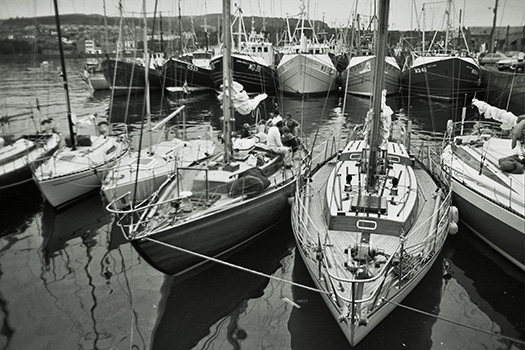 Some of the ISORA fleet during the period when Dickie Richardson chaired the organization during the 1970s. Included in this group sharing Howth Harbour with the fishing fleet in pre-marina days are Philip Watson & Kieran Jameson's J/24 Pathfinder II (third left), the famous S&S 40 Dai Mouse III which is now better known as Sunstone (centre left), and the McGruer 17-ton yawl Frenesi (centre right). Photo: W M Nixon
Some of the ISORA fleet during the period when Dickie Richardson chaired the organization during the 1970s. Included in this group sharing Howth Harbour with the fishing fleet in pre-marina days are Philip Watson & Kieran Jameson's J/24 Pathfinder II (third left), the famous S&S 40 Dai Mouse III which is now better known as Sunstone (centre left), and the McGruer 17-ton yawl Frenesi (centre right). Photo: W M Nixon
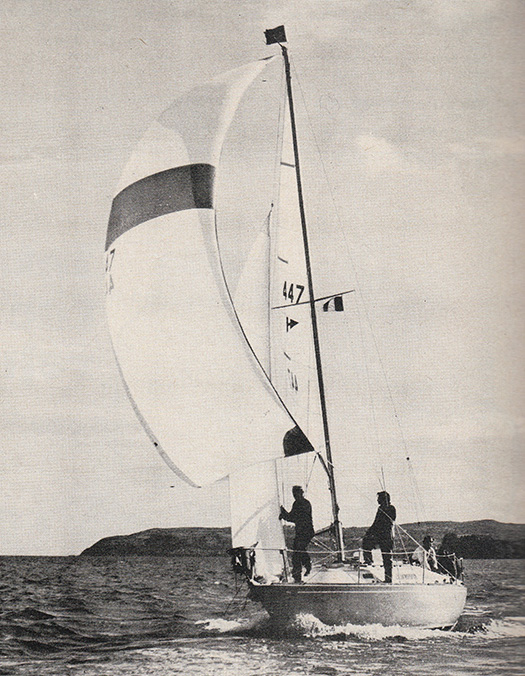 The Richardson's first boat with offshore racing ambitions was the Hustler 30 Skulmartin in 1971, which they finished from a bare hull. They were pioneers in the use of sails made by John McWilliam, who in those days operated under the Tasker label. Photo: W M Nixon
The Richardson's first boat with offshore racing ambitions was the Hustler 30 Skulmartin in 1971, which they finished from a bare hull. They were pioneers in the use of sails made by John McWilliam, who in those days operated under the Tasker label. Photo: W M Nixon
Dickie was to make his own first foray into being an offshore racing owner with the Hustler 30 Skulmartin, which he finished himself from a bare hull. That was his boat when ISORA was founded in 1971, but in late 1973 he bought the almost-new Billy Brown-designed Half Tonner Garland of Howth, which had won her class in the newly-inaugurated ISORA Captain's Cup Week in Holyhead, an event which in time developed into ISORA Week.
Dickie up-graded his new boat with a fractional rig, re-named her Blackwater in line with his policy of having boats named after navigation markers such as lightships in the Irish Sea, and took her in 1974 to the Half Ton Worlds in La Rochelle with a youthful Harold Cudmore as helmsman. In a large fleet they finished eight overall, but it was clear that new designs from Ron Holland and Doug Peterson were the future of offshore racing success. So Dickie and his teenaged sons acquired the bare hull of a Holland-designed Golden Shamrock from the builders in Cork, and finished her to become the Half Tonner Harry Furlong, named after a rock on the north coast of Anglesey.
Their former shipmate Harold Cudmore meanwhile was putting together his own Holland-designed Shamrock campaign with the intensely competitive Silver Shamrock, which duly won the Half Ton Worlds in Trieste in 1976, while back in the Irish Sea the hugely popular ISORA programme was to see Shamrocks in all their variations, Harry Furlong among them, featuring at the front end of the fleet.
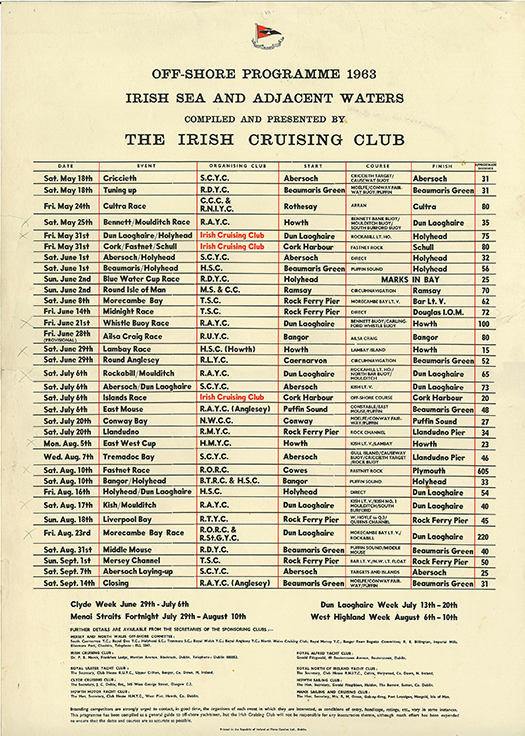
Until ISORA got itself up and running in 1971, all sorts of organisations were involved with distance racing in the Irish Sea. This is a programme issued by the Irish Cruising Club for the 1963 season.
Until Dickie Richardson with others like Hal Sisk from Dun Laoghaire launched the idea of an Irish Sea Offshore Racing Association after the end-of-season Pwllheli-Howth race in 1971, the offshore programme around the area had been fragmented, and date clashes were almost inevitable. Many organisations – some of them very informal - were involved, with the Irish Cruising Club and the Royal Alfred YC active on the Irish side, while in the north the Clyde Cruising Club interacted with the Belfast Lough clubs to run races across the North Channel. Over on the Welsh and English side, the Mersey & North Wales Joint Offshore Committee had developed into the Northwest Offshore Racing Association, and it was this body – with rapidly increasing numbers, particularly from the Irish side – which became ISORA in 1971 with its remit extending to include when possible events in the North Channel, and the annual Round Isle of Man Race, while also including an annual RORC event which might take the fleet to Cork.
What resulted was something which nowadays would be seen as an impossibly crowded and time-consuming programme. But it has to be remembered that times were very different during the 1970s. The Troubles were at their height, and links of friendship across the Irish Sea in a period of active terrorism could be difficult by any means other than a sailing boat. Thus the successful functioning of ISORA was definitely a power for the good, and at its height it had a remarkable fleet of 107 boats from all round the Irish Sea and adjacent areas taking part in its annual season-long championship. Its comprehensive programme, which guaranteed at least seven long weekends of sailing and racing afloat interspersed with friendship ashore in the ports visited, was exactly what people needed in those stressful times.
Inevitably, the challenges of running such an extraordinary and wide-ranging organization on an entirely voluntary basis were enormous, particularly as Dickie Richardson as chairman knew he had to do it with a minimum of fuss. This involved heroic restraint in diplomacy on his part, as normally he wasn't one to suffer fools gladly. Yet with the success of his efforts and those of his committee, for a while the clout of ISORA was such that they were able to hold impressive ISORA Weeks in Cork, Dublin Bay, Cardigan Bay off Abersoch and Pwllheli and even on the Clyde, thanks to their ability to bring a large fleet with them.
But it was all being done in a changing situation. An improved road network in England may have meant that owners from the big inland cities of the north could now reach their boats in Wales more easily, but for some of them an hour or two of extra travel meant they could access boats to race with the RORC fleet from the Solent, which provided modern facilities that far out-stripped the excessively tidal and very primitive harbours of North Wales, and the still-undeveloped ports on the Irish coast.
Then too, because the biennial ISORA Week mopped up all available fleets to one venue, other places felt left out and became more active in promoting their own regattas such as the Scottish Series on Loch Fyne. This clashed directly with the Irish Sea's Round the Isle of Man Race, and it was the latter which faded.
Perhaps most importantly of all, however, social attitudes were changing. The rough and ready approach of it being acceptable for dedicated offshore racing enthusiasts to disappear off for a very long weekend at least seven times a summer, often in order to race an event of barely a hundred miles, just didn't do in the modern family-oriented world.
This led to the introduction by individual clubs of longer events which featured a more clearly defined timescale, with the first biennial Round Ireland Race from Wicklow in 1980, while the National YC's Dun Laoghaire to Dingle Race – also biennial -arrived in 1993.
By that time the annual ISORA programme had been pared down to a more family-friendly scale, but sailing patterns had changed so much, with sunshine holidays afloat in warmer climes rising rapidly in popularity, that just a few years ago there actually was a move for the formal winding-up of ISORA. But happily that was averted, and the basics of the organization are still in being to provide manageable passage races for those who want them, and numbers are now modestly increasing.
Meanwhile for Dickie and Elspeth Richardson and their boys, in the late 1970s the focus of family life had increasingly moved towards their second home in Holyhead, while the pressure on the accelerator for offshore racing achievement was eased early in 1977 with the acquisition of the bare hull of an elegant Ohlson 38 which duly filled the front garden at Eshe Road North in Liverpool.

The new Ohlson 38 Matthew Walker off Holyhead SC (where Dickie Richardson had been Commodore) in 1977. Less than six months earlier, she'd been a bare shell in the Richardson's front garden in Liverpool. Photo: W M Nixon
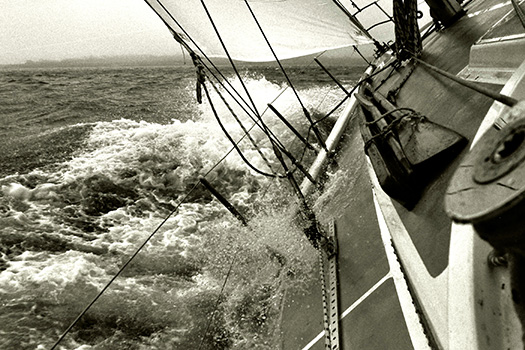
Ready and willing. Despite the rapidity of her completion, Matthew Walker in full commission to cruise to southwest Ireland within six months of the Richardson family taking delivery of the bare hull. Photo: W M Nixon
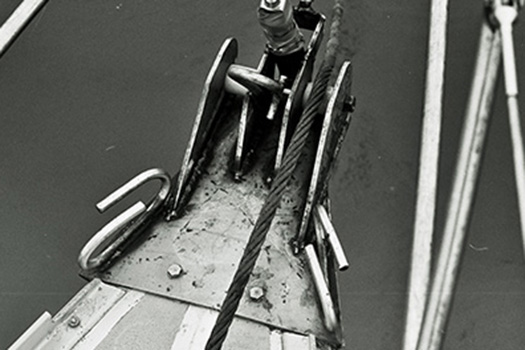
Classic Richardson work. In the summer of 1977, the stemhead fitting on Matthew Walker, which Dickie Richardson fabricated himself, still needed a bit of cosmetic work. But it did what was needed for the first cruise. Photo: W M Nixon
There was a longterm plan to re-emphasise their interest in cruising, but being the Richardsons, once the job was there to be done, it had to go ahead at great speed, for the hull had been delivered late. The new boat – called Matthew Walker – was put afloat in time for a summer cruise to southwest Ireland in the summer of 1977. Though she was still fairy basically finished in some areas, that could be sorted in time. But meanwhile she was certainly ready for sea and Dickie – after a final rush of work on the boat which saw him put in a seven day non-stop work programme – was sent below by his family to sleep as they cleared Holyhead Harbour. He woke up 48 hours later off the coast of West Cork.
In his work as a medical consultant, he was also always prepared to go the extra mile to achieve results, and in his Liverpool days he'd been on the Project Management Committee getting the huge new hospital into commission. He put in so much of his own time on this that when the massive facility finally opened, his sailing friends assumed that he'd be rewarded in some way in the British Honours List. But the word from within was that, in the quest to get the hospital up and running, he'd been so blunt abut the inadequacies of official management that he'd offended far too many NHS sensibilities to have any chance of receiving that well-earned gong.
On retirement Dickie and Elspeth moved to Porth y Fellyn in the almost rural western corner of Holyhead Harbour where they'd converted a former Methodist Chapel into a hospitable home for sailors in which they particularly valued their proximity to Holyhead Sailing Club, where he had served as Commodore, and frequently did duty as a Race Officer while being much involved with training and junior sailing, particularly through a thriving Optimist class.
Another project which suited his talents was done in concert with his longtime sailing friend Alan Stead, another sea-minded Liverpool anaesthetist who had also retired to the Holyhead area. They managed to secure a lease on some space on the inner part of Holyhead breakwater, got themselves an old crane, and offered DIY lay-up facilities to local boats in much the same style as Tower Quay in Birkenhead in the old days.
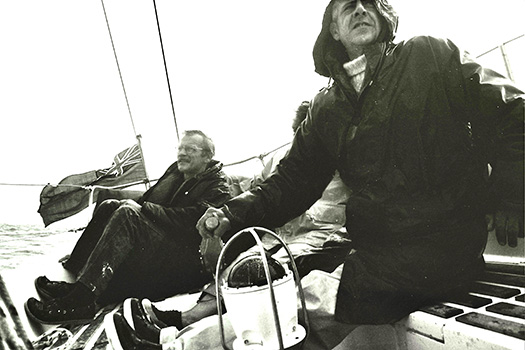
A man enjoying his new boat. Dickie Richardson finally relaxes aboard Matthew Walker after getting her completed and ready for sea in record time. On the helm is his old friend and fellow Tranmere SC stalwart Bert Whitehead, who was Honorary Treasurer of ISORA in the challenging early days. Photo: W M Nixon
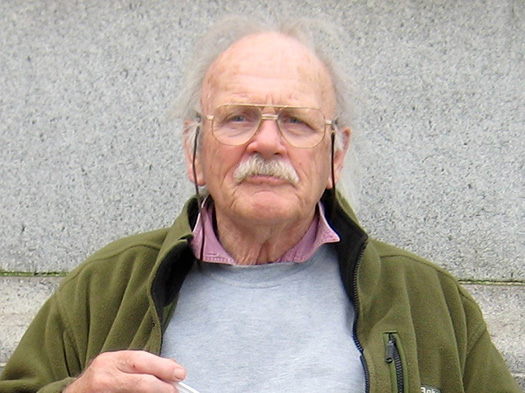
Senior sailor. A recent photo of the late Dickie Richardson. Photo: Holyhead SC
In his own sailing, Dickie threw himself into cruising the Ohlson 38 Matthew Walker with the same enthusiasm he'd devoted to offshore racing, and the Rias of Northwest Spain and the islands of the Outer Hebrides became favourite destinations. As for his talented sons, in their late teens and early twenties Angus and William did a spot of yacht design and building, the tiny and very attractive wishbone ketch Poacher being one of their products. But then William, like his younger brother Michael, went on to qualify as an advanced oil drilling engineer, and when the boys were home on leave from distant oilfields, Dickie particularly enjoyed discussion of the specialist techniques they had to use in a technically demanding profession.
Elspeth died in Holyhead on Christmas Day 2010, aged 86, and sadly for Dickie, he was also pre-deceased by his eldest son Angus in 2011. He himself soldiered on until January 2015. He would have much enjoyed his own funeral – it was a classic of its type. And should anyone suggests that the 1970s were a dull decade, rest assured they were no such thing when Dickie Richardson was around and firing on all cylinders, gruffly full of ideas and schemes and bubbling with his own quiet can-do enthusiasm. It was always a lively time in the Richardson orbit.
WMN
ISORA Races Both Sides of Irish Sea This Friday Night
#isora – There are two ISORA night races scheduled for this Friday night one on either side of the Irish Sea. The Dun Laoghaire Night Race (ISORA - Race 8a) is organised by the National Yacht Club in conjunction with the Royal Alfred Yacht Club Offshore Series. On the Welsh side, the Pwllheli Night Race (ISORA - Race 8b) is organised by Clwb Hwylio, Pwllheli Sailing Club.
Sailing Instructions for both races are attached.
'Raging Bull' Overtakes 'Errislannan' in 'Boat of the Year' Poll
Raging Bull overtook Errislannan in Afloat readers opinion poll at lunch time on who will win the Irish Cruiser Racing Association (ICRA) Boat of the Year Award, in just over a month's time. Over 350 voters have given their opinion so far on the ten boat shortlist produced by Afloat. Errislannan proved an early poll topper since voting began last Thursday but as late as lunchtime today votes for Raging Bull saw a dramatic lift, bringing the Irish Sea offshore champion ahead of the Top Cork week Sigma 38. At 2pm a third of the votes cast were for Raging Bull. Errislannan was on 31%. Tiger had 16% and was in third place ahead of Antix with 31 votes. The poll is located on the left hand column of the home page. Cast your vote now!
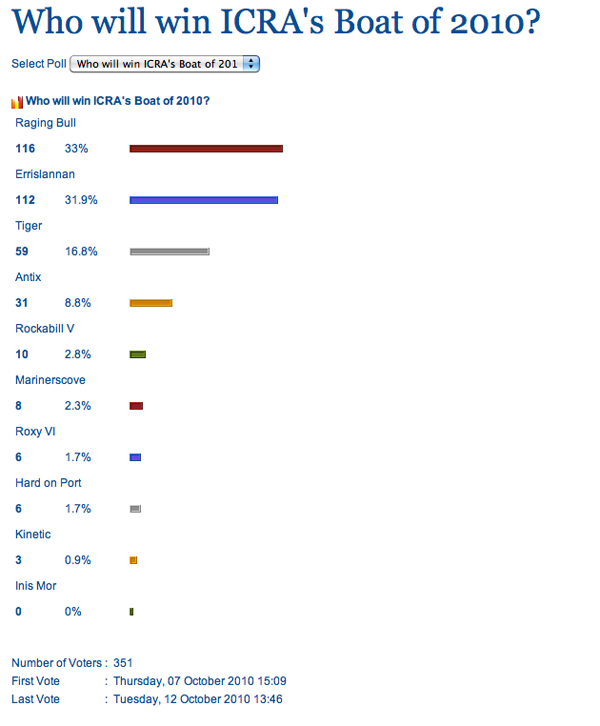
Roller Coaster Takes Overnight Race in a 'Virtual Calm'
From an entry list of 27 boats, 13 boats came to the line in Dun Laoghaire sailing for the 7th ISORA race writes Association Commodore Peter Ryan.
We had two new boats taking part in this race, “September Song” and “Windshift”. The course for the night was: Start – Muglins (S) – North India (P) – Muglins (P) – Finish. The whole race was going to be sailed against a foul tide.The forecast for the night looked perfect – 10kts South west and increasing during the night. It was expected that the fleet would be back in Dun Laoghaire soon after midnight. However this is not what happened!!!The race was started by Peter Beamish, Commodore of the Royal Alfred Yacht Club and Paul McCarthy.
The wind at the start was 14kts – east south east. This gave a beat to the Muglins. The wind direction was a perfect beat to North India. However, when the fleet was off Bray Head, the wind veered to a south west, favouring those boats who risked sailing under Bray Head.The fleet was well bunched as it rounded North India. “Roller Coaster” was the first to round with “Tsunami” snapping at it’s heels about 50m behind. The return leg was a tight reach with the wind decreasing.“Roller Coaster” led the fleet past Muglins and into Dublin Bay.
At this stage the fleet had become well spread out but “Tsunami” managed to keep up with “Roller Coaster”. After it rounded the Muglins it fell into the Dalkey Island “Hole” and “Tsunami” took advantage of this and passed it by sailing out into Dublin Bay.
This advantage was short lived when “Roller Coaster” again passed “Tsunami” at the back of the pier in a virtual clam before crossing the finish line at 03:23. “Tsunami” slunk across the line just over one minute behind “Roller Coaster”. The next boat to finish was “Lula Belle” over 80 minutes behind. The last boat finished at 06:01.“Roller Coaster” took line honours, 1st Overall and 1st in Class 1. “Tsunami” took 2nd Overall and 2nd Class1.
New comer “September Song” took 3rd Overall and 1st Class 2. “Rebellion” took 3rd Class 1 while “Lula Belle” took 2nd Class 2 and “Finnegan’s Wake took 3rd Class 2.The next race is on the 21st August with the ISORA / RAYC / Lee Overlay Day Race to the M2 buoy. Also, on the Welsh side, there will be a Day Race from Pwllheli on the same day.
ISORA Race Five Comes to Abrupt End
From an entry list of 27 sailing boats, 16 boats came to the line in Dun Laoghaire for the 5th ISORA race and first Sunday Race. Peter Ryan reports. It was hoped that this format would encourage those boats that regularly compete in the Dublin Bay and Howth racing and are reluctant to take part in ISORA as they would lose points in their Series. Unfortunately, this did not happen. We did not have any new boats competing.
The day looked ideal based on the weather forecast – 14kts West veering North West. With north-going spring tides the course selected was: Lambay (P)- Rockabill (S)- Kish (P) and to the finish. The course ensured that the fleet would have the tide with them all along the course. This was the only factor that remained constant.
The fleet left Dun Laoghaire in the 14kts westerly and made good progress across the bay towards the Bailey until it fell into a huge hole at the Bailey. For 30 minutes the only movement was the 1.5kt tide going north. Most of the fleet kept close to the shore while "Galileo" and "Tsunami" stayed out in the tide. At one time the shore side boats appeared to move again only to stop again. The wind filled in giving "Galileo" and "Tsunami" the advantage. "Intuition" was the lead shore boat and it also got the early wind. The wind had veered to the north-west and it was a fetch to Rockabill.
"Galileo" was first around Roackabill followed closely by "Intuition", Tsunami" and "Rebellion". The remainder of the fleet were well bunched close behind. Most of the run to Kish was in ideal sailing weather – moderate winds, sunshine, warm etc. This came to an abrupt end when the leaders were approaching Kish. A squall came through causing a rapid dropping of kites for the last mile. The same placings occurred at Kish as it was at Rockabill.
It was a beat to the finish. The wind had again dropped back to the 15kts after the squall. This left boats wondering if changing back up to the No.1's was required. The answer was not long in coming. A very strong squall hit the fleet with winds in excess of 28kts with driving rain sending boats scattering across Dublin Bay.
The first boat to cross the finish line was "Galileo", who only managed to take 2nd Overall and 2nd in Class 1. It was followed closely by "Intuition" who took 1st in both Overall and Class 1. "Tsunami" was next over the line to take 3rd in Class1 and 4th Overall. "Mojito" sailing two-handed took 3rd Overall and 1st in Class2. Another two-handed "Dinah" took 2nd Class2 while "Lula Belle" took 3rd Class2.
I would like to thank Larry Power of the National Yacht Club for doing the start and Chris Moore for recording the finishers. An "Après Sail" took place in the NYC after where the provisional results were announced.
The next race is on the 23rd July with the ISORA / RAYC / Lee Overlay Night Race to North India.
ISORA Get Ready to Race from Pwllheli to Wicklow
Just three weeks before the Round Ireland sailing race kicks off in Wicklow ISORA is preparing to race there in June 5th's race from Pwllheli in North Wales. When most regattas and events this season have struggled to raise entries the ISORA season has been marked with a dramatic rise, taking the offshore fleet to over 20 boats. Entry list and more details for he fourth race (inlcuding eve of race BBQ steaks in Wales) are on the ISORA thread on the Afloat forum here.




























